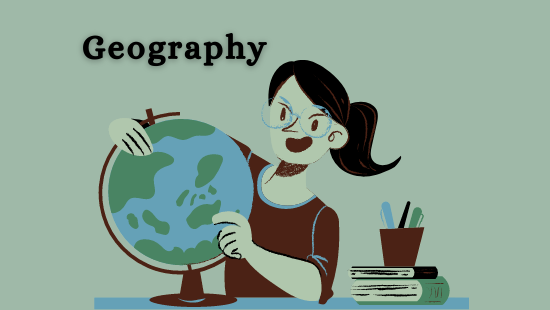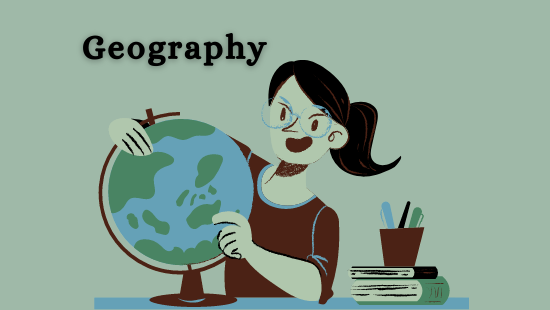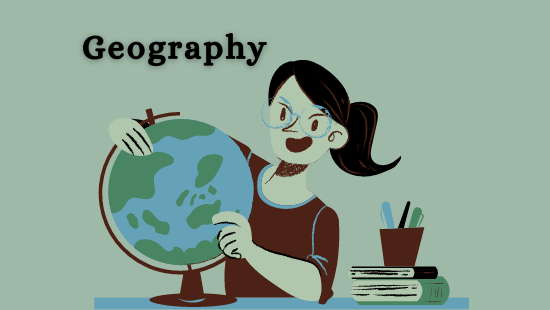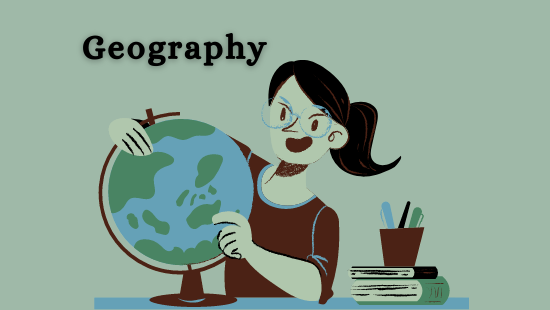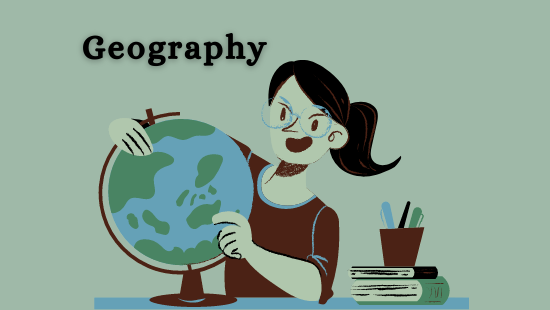
Geography Basics (Part-2)
Language: en
Geography Basics (Part-2)
Solar Nebula - It was a giant, rotating cloud of gas and dust from which the solar system formed.
As the Nebula collapsed under the force of its own gravity, it revolved faster and flattened into a disk. Most of the material in that disk was then pulled towards the center to form the sun. Other particles within the disk collided and stuck together to form ever-longer bodies including Earth. In this way, the Universe began which came to be known as Big Bang Theory.
UNIVERSE - All existing matter and space as a whole is known as the Universe. It is also known as Cosmos.
Galaxy - It consists of stars, dust, and dark matter. Billions of Galaxies are present in space.
Milkyway Galaxy - It consists of a star that is the Sun, dozens of moons, millions of asteroids & comets, and planets.
Solar System - Consists of sun, 8 planets, moons, asteroid belt, Kuiper Belt.
Asteroid Belt - Small rocky objects orbiting the sun like planets. They are present in between the planets Mars and Jupiter.
Kuiper Belt - It is the outermost part of the solar system present beside the planet Neptune. It consists of Icy objects of Frozen gases, rocks, and dust that orbit around the sun. It is also known as a comet.
Sun - It is the star that is present at the center of the solar system.
Planet - Any relatively large natural body that revolves in an orbit around the sun or around some other star.
There are 8 planets -
4 are rocky planets - Mercury, Venus,Earth, Mars
2 are Gas giants - Jupiter, Saturn
2 are Ice giants - Uranus, Neptune
Way to Remember all planets according to their position in the solar system-
Mercury Venus Earth Mars Jupiter Saturn Uranus Neptune
My Very Efficient Mother Just Served Us Nuts
Sun) Mercury) Venus) Earth) Mars) Asteroid Belt ) Jupiter) saturn) Uranus) Neptune) Kuiper Belt)
Mercury-
- Tilt-0০ degree
- Gravity-3.7 n/S2 , Density-5.43 g/ cm3
- Smallest planet in the solar system(4880 diameter)
- Closest to sun
- Although closest planet to sun, its surface can still be extremely cold due to thin atmosphere (exosphere)
- Daytime=840০F(450০C)
- Night time= -275০F(-170০C)
- Smallest than saturn’s moon Titan (Dia-5,149.5 km)
- And jupiter’s moon Ganymede (Dia-5,268.2 km)
- Slightly larger than Earth’s moon(Dia-3,474.8 km)
- Fastest planet in solar system (47 km/sec)
- Takes 88 days to complete one orbit around the sun, (Revolution)
- Takes 59 days to rotate on its axis.
Venus-
- Tilt-3০ degree
- Gravity-8.87 m/s2, Density-5.24g/cm3
- Hottest planet in solar system
- Mean Temp= 462০c-475০c (Hot enough to melt Lead)
- Because of high concentration of co2(Carbon dioxide) and thick atmosphere
- Spins clockwise( sun rises in west and sets in east) on its axis.
- Brightest planet in the solar system. (because of sulfuric acid in its atmosphere which makes it reflective and shiny).
- Its brightness makes it visible even during the day from earth if the sky is clear.
- Thick yellowish clouds of sulphuric acid traps heat which causes a greenhouse effect.
- The planet is named after the Roman Goddess of Love and Beauty.
- It is the First planet to be explored by a spacecraft of NASA named Mariner 2 on Dec 14,1962.
Earth-
- Tilt-2312 degree
- Gravity-9.807 n/s2, Density-5.52gm/cm3
- Revolve around the earth=365.25 days
- Rotate on its axis=23.9 hours
- Moves from west to east
Mars-
- Tilt-25.2 degree
- Gravity-3.721 m/s2, Density-3.93 g/cm3
- It is the 2nd smallest planet in solar system (diameter-6786.604 km)
- It has two moons -Deimos and phobos( Two horses who pull the Roman God of War-Mar’s chariot).
- They may be asteroids captured by Mars's gravity.
- It has a much thinner atmosphere that contains more than 95% of Carbon dioxide and much less than 1% oxygen.
- Average temperature is about -80০F(-60০c)
- It has very weak gravity (3.721 m/s2) which is 37% less than on Earth that means we can jump 3X higher than on Earth.
- The North Polar Basin, commonly known as Borealis Basin, is a large basin present in the northern hemisphere of mars that covers 40% of mars planet.
- It has the largest Canyon in Solar system named Valles Marineris
- It is covered by soil, rock and dust made from Iron oxide which gives the surface a red rusty colour. That is the reason it is called the Red planet.
- It is the only planet where we have sent rovers to roam in the landscape.
Jupiter-
- Tilt-3.13 degree
- Gravity-24.79 m/s2 , Density-1.33 g/cm3
- It is the largest planet in the solar system.
- It has windy clouds of Ammonia and water.
- Its atmosphere contains Hydrogen and Helium.
- It has a Great Red spot which is created by turbulent and Fast moving atmospheres.
- The Great Red spot was 1st Identified in 1665 by Italian astronomer Giovanni Cassini’.
- It is the 3rd brightest object in the Solar system after Venus and Moon.
- It has 79 moons (Famous -Europa, Callisto,Ganymede)
- It is the fastest spinning planet in the solar system having Rotational Velocity of 12.6 km/s or 45,300 km/hr.
- It rotates on its axis in 10 hours (1 rotation)
- It revolves around the sun( 1 revolution)=12 years
- It has a cloud of 50km thick which is made of ammonia crystals.
- It has 4 sets of rings-Halo
Main
Amalthea Gossamer
Thebe Gossamer
If Earth= 1 grape
Then Jupiter= 1 Basketball
Saturn-
- Tilt-27০degree
- Gravity- 10.44 m/s2 Density- 0.69 g/cm3
- It is the second largest planet in the solar system.
- It has 7 rings which are made of rocks and dust particles.
- 1 Rotation= 10.7 hours(10 hours 32 mins 35 secs)
- 1 Revolution= 29 years
- Its atmosphere contains Hydrogen (H2) and Helium(He).
- (8) It is the least dense of all the planets (0.687g/cm3)
- It is the only planet which is less dense than water (1g/cm3)
- It has 82 moons from which 53 are known and 29 moons are awaiting confirmation.
- Titan- 2nd largest moon after Jupiter's Ganymede in the solar system.
- Galileo Galilei was the first person to see Saturn's rings in 1610 but he thought it was because two moons got strucked.
- In 1655, Dutch astronomer Christian Huygens proposed that Saturn had thin, Flat rings.
- He was also the First person to discover Saturn’s largest moon , Titan.
- The First spacecraft to reach Saturn was Pioneer II in 1979.
Uranus-
- Tilt- 98 degree
- Gravity- 8.87 m/s2 Density- 1.27 g/cm3.
- It is the 3rd largest planet in our solar system.
- It is the 1st planet to be found with the aid of a telescope.
- The planet was discovered by William Herschel in 1781.
- The planet was named after the Greek God of the sky suggested by Astronomer Johann Elert Bode.
- 1 Rotation=17 hours
- 1 Revolution=84 years
- It rotates from east to west like Venus.
- It contains Icy materials of water, methane and Ammonia.
- The atmosphere contains molecular Hydrogen, Atomic Helium and a small amount of Methane.
- It has 27 moons.
- It contains 13 known rings
Inner rings-narrow and dark
Outer rings- brightly coloured
- Voyager 2 is the only spacecraft to fly by Uranus.
If Earth= Apple
Than Uranus= Basketball
Neptune-
- Tilt- 28.5 degree
- Gravity- 11.15 m/s2 , Density- 1.64 g/cm3
- Its atmosphere contains molecular hydrogen, atomic helium and methane.
- It has 14 moons.
- It has at least 5 main rings and four prominent ring arcs which are clumps of dust and debris.
- It has dense Fluid of Icy materials of water, methane, and ammonia.
- 1 Rotation=16 hours
- 1 Revolution=165 years
- It is the only planet in our solar system which is not visible to the naked eye.
- It was discovered in 1846.
- Voyager 2 is the only spacecraft to have visited Neptune
If Earth=Apple
Then Neptune =Basketball
Sun-
- 1 Rotation= 26 days ( Rotates from west to east)
- It’s Atmosphere contains 3 layers-Photosphere
-Chromosphere
- Corona
- When magnetic energy is released by the sun during magnetic storms, solar flares occur which we see on Earth as sunspots.
- Sunspots are dark areas on the sun’s surface caused by magnetic variations.
- The reason they appear dark is due to their temperature being much lower than surrounding areas.
- Solar winds are ejections of plasma(extremely hot charged particles) that originate in the layer of the sun known as the corona.
- It takes 8 minutes 20 secs or 500 seconds for light to reach the earth from the sun.
- Speed of light=3,00,000 km/sec.
Moon-
- 5th largest Moon in the solar system.
- It has a thin atmosphere.
- The Moon's presence helps stabilize our planet’s wobble and moderate our climate.
- It has a thin atmosphere(exosphere)
- It formed after a Mars-sized body collided with Earth.
- The moon appears reddish mainly during the Lunar eclipse because the only remaining sunlight reaching the moon at that point is from around the edges of the Earth.
- Moon formed after a Mars -Sized body collided with Earth.
- It is the only celestial body beyond Earth that is visited by Human beings.
- Moonquakes occur frequently.
- Moon-Earth distance =3,85,00 km.
Earth’s surface-
- Diameter-12,742 km(In equator)
- Diameter from North [ole to South pole-12,725 km.
- Poles are flattered where as equator is bulge due to Earth’s surface is covered with 4 spheres (earth’s rotation)
- Earth’s surface contains 4 spheres-
Lithosphere(Land)
Hydrosphere(Ocean)
Atmosphere(Air)
Biosphere(Vegetation, Plants and Animals)
Earth’s Atmosphere-
Contains-
Nitrogen-78%
Oxygen-21% (47% of weight of all rock)
Other gases (silicon-27%, Aluminium-8%, Calcium-4%, Iron-5%, Na,argon, co2K,Mg-2%)
Water - 1%
Water Vapour, co2 & other gases trap heat from the sun causing warm atmosphere in Earth which is known as Greenhouse effect, without which, earth would probably be too cold for life to exist.
A runaway greenhouse effect led to the hellish conditions of Venus' current surface.
Earth’s Atmosphere contains many Layers such as-
Troposphere(0 to 12 -18 km) (15 to -56.5o c)
Stratosphere(11 to 50 km) (-56.5 to -2.5o c)
Mesosphere (40-50 to 80-90 km) (-2.5 to -86.5o c)
Ionosphere (In between Mesosphere & Exosphere)
Thermosphere (80-90 to 800 km)(-86.5 to 1200o c)
Exosphere (800 to 3000 km)( 1200o c)
Troposphere- Aeroplane, Hot air balloon Flies.
Stratosphere- Ozone layer, Radiosonde.
Mesosphere- Rocket, Meteors
Thermosphere- Auroras
Exosphere- Spaceship, satellite
Ionosphere- International space station, Radio signals.
Earth’s Interior structure-
Contains
Crust- It is the top component of the lithosphere.
There are two types of crust
Dryland of continents
Ocean Floors
The dryland of continents consists of granite and other light silicate minerals.
Ocean Floors are made up mostly of a dark, dense volcanic rock called Basalt.
Continental Crust =40 km thick
Oceanic crust = 8 km thick
Mantle - It consists of Upper Mantle, Lower Mantle
It is the thick layer of hot, solid rock between the crust and the molten core.
It contains Iron and Magnesium-rich silicate rock (A combination of Silicon and Oxygen known as silica and minerals that contain silica are known as silicate minerals).
Thickener=2900km
Core - Outer core
Inner core
The Innermost part of Earth contains Iron and nickel & small amounts of sulphur and oxygen.
Outer core-2,250 km-Liquid
Inner core-2600 km-Solid
The core is responsible for the planet’s magnetic field, which helps to deflect harmful charged particles shot from the sun.
Earth’s magnetic field is generated by currents Flowing in the outer core.
Plate Tectonics - Outer crust of the Earth is broken up into regions known as tectonic plates which are Floating on top of the magma interior.
The slow motion of rock in the mantle shuffles continents around and causes earthquakes, volcanoes, and the formation of mountain ranges.
Auroras - When charged particles from the sun get trapped in Earth’s magnetic field, they smash into air molecules above the magnetic poles, causing them to glow.
In simple terms, when solar winds come in contact with Earth’s magnetic field, different light glows which is known as Auroras.
Two types of Auroras-
Aurora Borealis - (In North pole)
Aurora Australis - (In South pole)
General Knowledge-
4.6 billion years ago on Earth-
1 day= 6 hours
620 million years ago on Earth-
1 day= 21.9 hours
Presently 1 day = 24 hours
Reason-
- The Moon is slowing down Earth’s rotation through the tides
- Due to the increasing mass of Earth.
- If Earth were a perfect sphere, its gravitational field would be the same everywhere.
- The pull of gravity on Earth changes due to many reasons-
- The surface is bumpy and water flow
- Ice drift
- Movement of the tectonic plates beneath Earth’s crust.
Earth is the only planet to have plate Tectonics.
Big to small planets
Planet diameter
1-Jupiter (139822 km)
2-Saturn (116464 km)
3-Uranus (50724 km)
4-Neptune (49244 km)
5-Earth (12742 km)
6-Venus (12104 km)
7-Mars (6779 km)
8-Mercury (4880 km)
Brightest object
1-Sun
2-Moon
3-Venus
4-Jupiter
5-Mars
6-Mercury
7-Saturn
8-Ganymede
Continents Big to small
Asia
Africa
North America
South America
Antarctica
Europe
Australia
Oceans-Big to small
Pacific
Atlantic
Indian
Southern
Arctic
RATINGS
No reviews yet, be the first one to review the product
